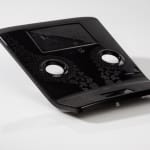
With a practice-oriented two-day event on 19–20 November 2019 in Schwertberg, Austria, Engel is continuing the very successful series of conferences on foam injection moulding. What is new about the upcoming event is that it will not only be about physical MuCell foaming but also about other physical and chemical foaming processes from different technology suppliers. The event is aimed at plastics processors and mould makers as well as developers and designers. The conference languages will be German and English.

Components produced by foam injection moulding are about 20 percent lighter than components produced by compact injection moulding
“Foam injection moulding has established itself very well and is one of the most important lightweight construction technologies,” emphasises Wolfgang Kienzl, technology specialist for foam injection moulding at Engel Austria. “The range of different foaming processes is now broad. In any case, application know-how is important for a good injection moulding result. Engel supports its customers in selecting the most suitable process for each specific application and in implementing it in their operations.”
Physical versus chemical foaming
Which process is best suited for which application? The conference will provide answers to this question. In addition to the MuCell technology developed by Trexel, direct injection into the plasticising barrel, two other physical foam injection moulding processes will be discussed. The first process is SOMOS Perfoamer developed by ProTec Polymer Processing where the plastic granulate is enriched with CO2 in an autoclave and then further processed, and the second process is iQ FOAM developed by Volkswagen where an airlock draws in the gas together with the material to charge the gas.
In the chemical foaming process, a blowing agent is mixed into the granulate as a masterbatch (CBA), which does not require any modification to the injection moulding machine. As a result, the process is relatively simple and cost-effective to implement, which is why chemical foaming is experiencing an increase in demand.
High-profile speakers will present the various processes, report on their practical experience and give an insight into current research and development. They come from the mechanical and plant engineering sector, the raw materials production sector and universities. The range of topics covers the entire process chain, from component development and design to materials and the injection moulding process to surface technology. Live demonstrations of both physical and chemical foaming will allow the conference participants to experience first-hand how theory can be put into practice.
Weight savings of up to 20 percent
What unites all the different foam injection moulding processes is the motto: Saving without compromising. High-quality components can be produced which are up to 20 percent lighter than the compact versions. They show their advantages primarily where in addition to weight reduction shape accuracy, dimensional accuracy, insulation properties and production efficiency are important.
Under the name of foammelt, Engel offers tailor-made system solutions based on both physical and chemical foaming technologies for a wide range of foaming requirements.
Source: Engel


